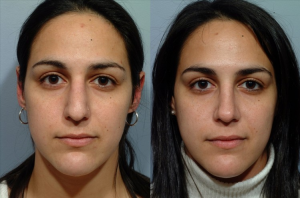
DO I NEED SEPTOPLASTY OR RHINOPLASTY?
When most people think of nose surgery, they are thinking of rhinoplasty, which is a surgical procedure that can improve the appearance of the nose. Another lesser-known nose surgery is septoplasty, which is a surgical procedure that can improve functionality (i.e., breathing) of the nose. These two nose surgeries can produce highly satisfying results and may even be performed together as a septorhinoplasty to enhance both the appearance and function of the nose.
SEPTOPLASTY
Septoplasty is a nose surgery that specifically improves nasal breathing by correcting a deviated septum. A deviated septum occurs when the wall between the two sides of the nose becomes crooked, most commonly due to an injury or trauma during birth. While a mildly deviated septum is common, some people suffer from perpetual blockage of one side of the nose and cannot breathe as easily as they should. Septoplasty can straighten a deviated septum and create more open airways for nasal breathing. An important difference between rhinoplasty and septoplasty is that if you are ONLY getting a septoplasty, there will be no change whatsoever to the outside of your nose—no cast and no black-and-blue eyes.
Learn more about our NYC Septoplasty >>
RHINOPLASTY
Rhinoplasty is a nose surgery that specifically improves the appearance of the nose. This procedure may lengthen the nose, widen it, strengthen or straighten the nasal bridge, correct the angle of the nose, adjust the shape or size of the nasal tip, or perform a number of other aesthetic improvements. Rhinoplasty can make the nose appear more balanced and aesthetically pleasing in comparison to the other facial features.
Learn more about our NYC Rhinoplasty >>
KEY DIFFERENCES
- Purpose: Septoplasty achieves functional restoration, whereas rhinoplasty achieves cosmetic improvement.
- Adjustments: Septoplasty alters the septum and inner nasal structures, whereas rhinoplasty alters the structures that affect the outer appearance.
- Surgical Technique: Septoplasty uses endonasal techniques inside the nose, whereas rhinoplasty can use a closed or open surgical approach.
- Scarring: Septoplasty leaves no noticeable scarring, whereas rhinoplasty (if using the open surgical approach) may leave an inconspicuous scar at the base of the nose.
- Insurance Coverage: Septoplasty may be partially or fully covered by insurance, whereas rhinoplasty is not usually covered by insurance.
SEPTORHINOPLASTY
Dr. Pearlman will examine every patient for a deviated septum even if they are only seeking rhinoplasty. This is because adjustments made during the rhinoplasty procedure may lead to more nasal blockage in patients with a mildly deviated septum, which can aggravate breathing issues and create a need for septoplasty in the future. To correct a deviated septum and perform desired aesthetic changes, Dr. Pearlman can perform a septorhinoplasty, which includes septoplasty and rhinoplasty as one operation.
If you are interested in undergoing septoplasty, rhinoplasty, or septorhinoplasty, schedule your personal consultation with Dr. Steven J. Pearlman. Dr. Pearlman is dual board certified in both facial plastic and reconstructive surgery and in Otolaryngology – Head and Neck Surgery (Ear Nose and Throat), and he would be pleased to help you achieve your goals with nose surgery. Call 212-223-8300 or fill out our online contact form to schedule your consultation with Dr. Pearlman today.




